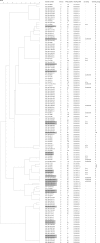Norwegian sheep are an important reservoir for human-pathogenic Escherichia coli O26:H11
- PMID: 22492457
- PMCID: PMC3370565
- DOI: 10.1128/AEM.00186-12
Norwegian sheep are an important reservoir for human-pathogenic Escherichia coli O26:H11
Abstract
A previous national survey of Escherichia coli in Norwegian sheep detected eae-positive (eae(+)) E. coli O26:H11 isolates in 16.3% (80/491) of the flocks. The purpose of the present study was to evaluate the human-pathogenic potential of these ovine isolates by comparing them with E. coli O26 isolates from humans infected in Norway. All human E. coli O26 isolates studied carried the eae gene and shared flagellar type H11. Two-thirds of the sheep flocks and 95.1% of the patients harbored isolates containing arcA allele type 2 and espK and were classified as enterohemorrhagic E. coli (EHEC) (stx positive) or EHEC-like (stx negative). These isolates were further divided into group A (EspK2 positive), associated with stx(2-EDL933) and stcE(O103), and group B (EspK1 positive), associated with stx(1a). Although the stx genes were more frequently present in isolates from patients (46.3%) than in those from sheep flocks (5%), more than half of the ovine isolates in the EHEC/EHEC-like group had multiple-locus variable number of tandem repeat analysis (MLVA) profiles that were identical to those seen in stx-positive human O26:H11 isolates. This indicates that EHEC-like ovine isolates may be able to acquire stx-carrying bacteriophages and thereby have the possibility to cause serious illness in humans. The remaining one-third of the sheep flocks and two of the patients had isolates fulfilling the criteria for atypical enteropathogenic E. coli (aEPEC): arcA allele type 1 and espK negative (group C). The majority of these ovine isolates showed MLVA profiles not previously seen in E. coli O26:H11 isolates from humans. However, according to their virulence gene profile, the aEPEC ovine isolates should be considered potentially pathogenic for humans. In conclusion, sheep are an important reservoir of human-pathogenic E. coli O26:H11 isolates in Norway.
Figures

References
-
- Aktan I, et al. 2004. Characterisation of attaching-effacing Escherichia coli isolated from animals at slaughter in England and Wales. Vet. Microbiol. 102:43–53 - PubMed
-
- Bettelheim KA. 2007. The non-O157 Shiga-toxigenic (verocytotoxigenic) Escherichia coli; under-rated pathogens. Crit. Rev. Microbiol. 33:67–87 - PubMed
Publication types
MeSH terms
Substances
LinkOut - more resources
Full Text Sources

